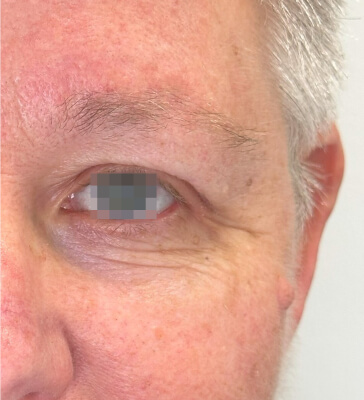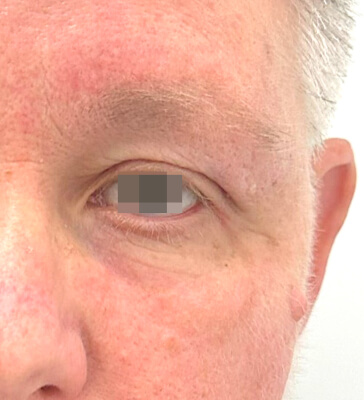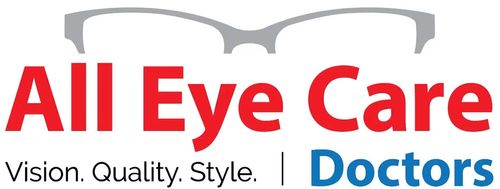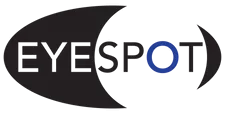Tone The Muscles To Address Lower Lid Laxity And Impaired Blinking
As you age, the delicate muscles around your eyes can begin to weaken, leading to droopy eyelids, ineffective blinking, and uncomfortable dry eye symptoms. For patients seeking relief, All Eye Care Doctors and EYESPOT now offer OptiLIFT, an innovative treatment that addresses both the functional and aesthetic concerns associated with lower lid laxity.
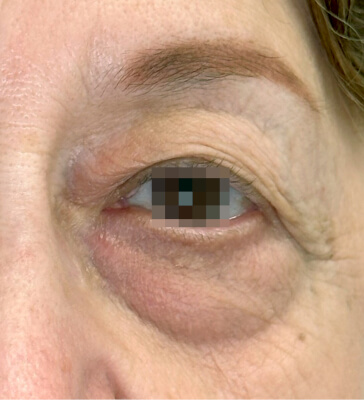
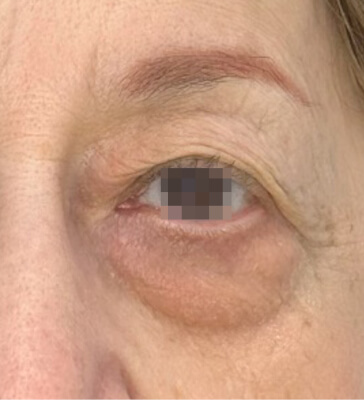
What is Lower Lid Laxity?
Lower lid laxity occurs when the muscles supporting the lower eyelid, primarily the orbicularis oculi muscle, lose strength and tone due to natural aging processes. Research indicates that skeletal muscles lose 3-8% of their mass each decade after age 30, and the periorbital area is particularly susceptible to these changes.
When lower lid muscles weaken, several problematic symptoms can develop. The eyelid may sag away from the eye surface, creating gaps that allow tears to evaporate more quickly.
This structural change also impairs the natural blinking mechanism, preventing the eyelids from fully closing and distributing tears across the eye surface effectively. Patients with lower lid laxity often experience persistent dry eye symptoms, including burning, irritation, excessive tearing, and a gritty sensation.
The cosmetic impact can be equally distressing, as droopy lower lids contribute to an aged, tired appearance that affects self-confidence and quality of life.
How OptiLIFT Works
Non-Surgical Device to Tone Muscles to Address Droopy Eyelids
OptiLIFT addresses lower lid laxity through its innovative Dynamic Muscle Stimulation technology (DMSt). This advanced system delivers precisely calibrated electrical pulses to trigger nerve signals in the facial muscles, inducing controlled muscle contractions that strengthen and tone the periorbital area.
The treatment process activates the orbicularis oculi muscle and surrounding supportive tissues through targeted electrical stimulation. These controlled contractions function similarly to exercise for the facial muscles, gradually restoring strength, tone, and structural support to the lower eyelid.
As muscle function improves, the lid regains its proper position against the eye surface, enabling more effective blinking and better tear distribution. OptiLIFT’s applicator is specifically designed for the delicate periorbital area, featuring three predefined treatment presets that accommodate different facial contours and patient needs.
This specialized design ensures optimal energy delivery while maintaining patient comfort throughout the treatment process. The technology also incorporates a radiofrequency component that delivers precise heat to deeper skin layers, stimulating collagen production and enhancing the overall tightening effect.
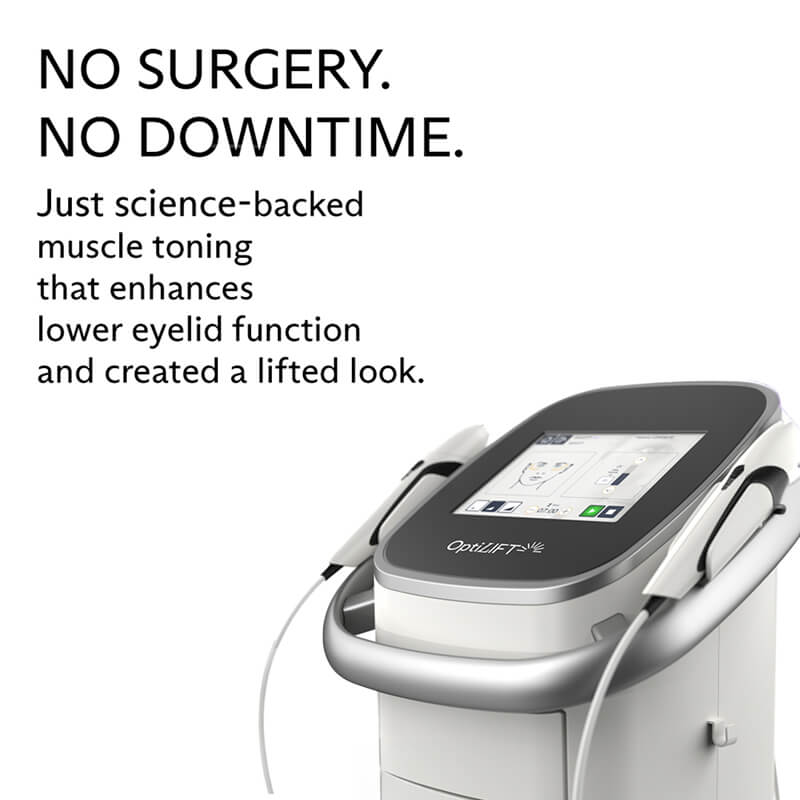
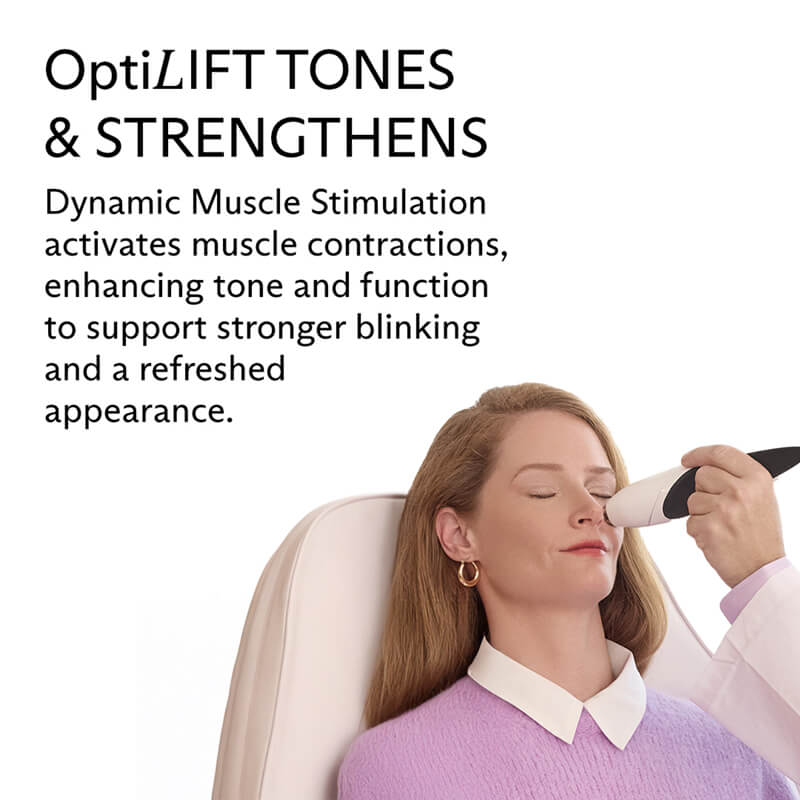
What to Expect During Your Treatment
Each OptiLIFT session typically lasts 15-20 minutes and requires no anesthesia or numbing agents. Patients remain comfortably seated while the specially designed applicator delivers targeted muscle stimulation to the periorbital area.
Most patients describe the sensation as gentle muscle contractions, and the treatment intensity can be adjusted based on individual comfort levels and specific clinical needs. There is no downtime required, allowing patients to return to normal activities immediately following each session.
Most patients experience minimal side effects, which may include temporary mild redness or slight muscle tenderness immediately following treatment that typically resolve within a few hours. The non-invasive nature of OptiLIFT eliminates risks associated with surgical procedures, such as infection, scarring, or extended recovery periods.
The complete OptiLIFT protocol typically involves four treatment sessions spaced one to two weeks apart. Some patients may notice improvements after the first session, though the full benefits become most apparent following the complete treatment series.
Clinical studies suggest that results can last 12-18 months, though individual experiences may vary. Maintenance treatments can help sustain benefits over time.
Who is a Good Candidate for OptiLIFT?
Ideal candidates for OptiLIFT include patients with mild to moderate lower lid laxity, those experiencing dry eye symptoms related to poor blinking mechanics, and individuals seeking non-surgical alternatives to traditional lid tightening procedures. Certain conditions may disqualify patients from OptiLIFT treatment, including pregnancy, the presence of pacemakers or other electronic implants, active infections in the treatment area, or severe neurological conditions affecting muscle function.
During the consultation process, our team thoroughly reviews each patient’s medical history to ensure treatment safety and appropriateness. If you’re experiencing persistent dry eye symptoms, notice changes in your eyelid position, or are concerned about the appearance of droopy lower lids, OptiLIFT may offer the relief you’ve been seeking.
Schedule a consultation at All Eye Care Doctors to determine if OptiLIFT could be right for you.
